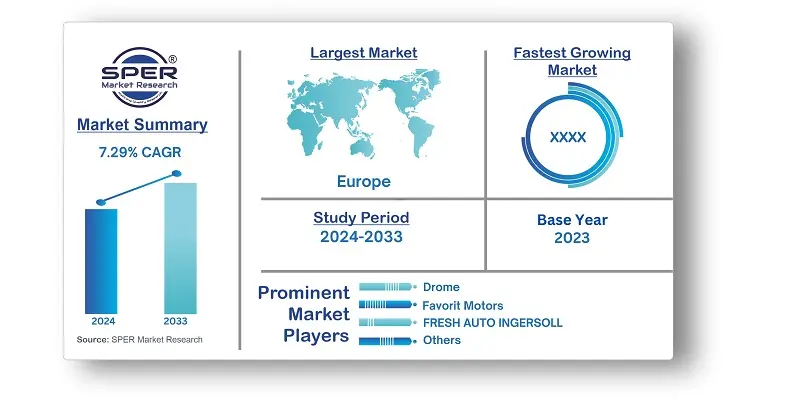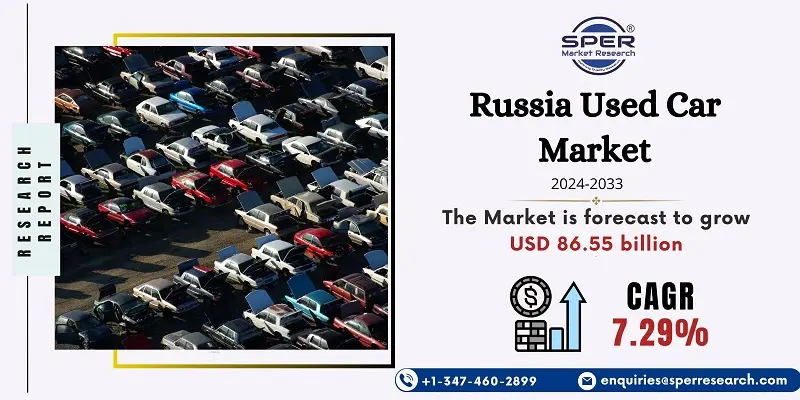
Russia Used Car Market Growth, Size, Trends, Demand, Share, Revenue and Future Outlook
Russia Used Car Market Size- By Car Type, By Propulsion, By Vendor Type- Regional Outlook, Competitive Strategies and Segment Forecast to 2033
| Published: Mar-2024 | Report ID: AMIN2479 | Pages: 1 - 108 | Formats*: |
| Category : Automotive & Transportation | |||
- March 2022, Inchcape declared that company would withdraw from the Russian market due to the ongoing situation in Ukraine. The company declared that in view of the current circumstances, it has determined that the Group's ownership of its economic interests in Russia is no longer viable.
- Russia's biggest auto dealer, Rolf, was acquired by competitor KlyuchAvto in December 2021 for an unknown sum. The acquisition will be financed by Alfa Bank, according to the announcement. Unidentified sources estimate the deal's value between $400 and $500 million, which is at least three times less what Petrov had originally anticipated to make from the company's sale.


| Report Metric | Details |
| Market size available for years | 2020-2033 |
| Base year considered | 2023 |
| Forecast period | 2024-2033 |
| Segments covered | By Car Type, By Propulsion, By Vendor Type |
| Regions covered | Eastern Region, Western Region, Southern Region, Northern Region |
| Companies Covered | Drome, Favorit Motors, FRESH AUTO INGERSOLL, Gesner Auto, Green Giant (B&G Foods), Inchcape plc., JSC AVTOVAZ, ROLF, TrueCar Inc., Others. |
- Budget-Conscious Consumers
- College Students
- Families on a Budget
- First-Time Car Buyers
- Small Business Owners
- Temporary Residents or Expats
| By Car Type: |
|
| By Propulsion: |
|
| By Vendor Type: |
|
- Russia Used Car Market Size (FY’2024-FY’2033)
- Overview of Russia Used Car Market
- Segmentation of Russia Used Car Market By Car Type (Hatchback, Sedan, SUV)
- Segmentation of Russia Used Car Market By Propulsion (Internal Combustion Engine, Electric)
- Segmentation of Russia Used Car Market By Vendor Type (Organized, Unorganized)
- Expansion Analysis of Russia Used Car Market
- Problems and Obstacles in Russia Used Car Market
- Competitive Landscape in the Russia Used Car Market
- Impact of COVID-19 and Demonetization on Russia Used Car Market
- Details on Current Investment in Russia Used Car Market
- Competitive Analysis of Russia Used Car Market
- Prominent Players in the Russia Used Car Market
- SWOT Analysis of Russia Used Car Market
- Russia Used Car Market Future Outlook and Projections (FY’2024-FY’2033)
- Recommendations from Analyst
1.1. Scope of the report1.2. Market segment analysis
2.1. Research data source2.1.1. Secondary Data2.1.2. Primary Data2.1.3. SPER’s internal database2.1.4. Premium insight from KOL’s2.2. Market size estimation2.2.1. Top-down and Bottom-up approach2.3. Data triangulation
4.1. Driver, Restraint, Opportunity and Challenges analysis4.1.1. Drivers4.1.2. Restraints4.1.3. Opportunities4.1.4. Challenges4.2. COVID-19 Impacts of the Russia Used Car Market
5.1. SWOT Analysis5.1.1. Strengths5.1.2. Weaknesses5.1.3. Opportunities5.1.4. Threats5.2. PESTEL Analysis5.2.1. Political Landscape5.2.2. Economic Landscape5.2.3. Social Landscape5.2.4. Technological Landscape5.2.5. Environmental Landscape5.2.6. Legal Landscape5.3. PORTER’s Five Forces5.3.1. Bargaining power of suppliers5.3.2. Bargaining power of buyers5.3.3. Threat of Substitute5.3.4. Threat of new entrant5.3.5. Competitive rivalry5.4. Heat Map Analysis
6.1. Russia Used Car Market Manufacturing Base Distribution, Sales Area, Product Type6.2. Mergers & Acquisitions, Partnerships, Product Launch, and Collaboration in Russia Used Car Market
7.1. Russia Used Car Market Value Share and Forecast, By Car Type, 2024-20337.2. Hatchback7.3. Sedan7.4. SUV
8.1. Russia Used Car Market Value Share and Forecast, By Propulsion, 2024-20338.2. Internal Combustion Engine8.3. Electric
9.1. Russia Used Car Market Value Share and Forecast, By Vendor Type, 2024-20339.2. Organized9.3. Unorganized
10.1. Russia Used Car Market Size and Market Share
11.1. Russia Used Car Market Size and Market Share By Car Type (2020-2026)11.2. Russia Used Car Market Size and Market Share By Car Type (2027-2033)
12.1. Russia Used Car Market Size and Market Share By Propulsion (2020-2026)12.2. Russia Used Car Market Size and Market Share By Propulsion (2027-2033)
13.1. Russia Used Car Market Size and Market Share By Vendor Type (2020-2026)13.2. Russia Used Car Market Size and Market Share By Vendor Type (2027-2033)
14.1. Russia Used Car Market Size and Market Share By Region (2020-2026)14.2. Russia Used Car Market Size and Market Share By Region (2027-2033)14.3. Eastern Region14.4. Northern Region14.5. Western Region14.6. Southern Region
15.1. Drome15.1.1. Company details15.1.2. Financial outlook15.1.3. Product summary15.1.4. Recent developments15.2. Favorit Motors15.2.1. Company details15.2.2. Financial outlook15.2.3. Product summary15.2.4. Recent developments15.3. FRESH AUTO INGERSOLL15.3.1. Company details15.3.2. Financial outlook15.3.3. Product summary15.3.4. Recent developments15.4. Gesner Auto15.4.1. Company details15.4.2. Financial outlook15.4.3. Product summary15.4.4. Recent developments15.5. Green Giant (B&G Foods)15.5.1. Company details15.5.2. Financial outlook15.5.3. Product summary15.5.4. Recent developments15.6. Inchcape plc.15.6.1. Company details15.6.2. Financial outlook15.6.3. Product summary15.6.4. Recent developments15.7. JSC AVTOVAZ15.7.1. Company details15.7.2. Financial outlook15.7.3. Product summary15.7.4. Recent developments15.8. ROLF15.8.1. Company details15.8.2. Financial outlook15.8.3. Product summary15.8.4. Recent developments15.9. TrueCar Inc.15.9.1. Company details15.9.2. Financial outlook15.9.3. Product summary15.9.4. Recent developments15.10. Others
SPER Market Research’s methodology uses great emphasis on primary research to ensure that the market intelligence insights are up to date, reliable and accurate. Primary interviews are done with players involved in each phase of a supply chain to analyze the market forecasting. The secondary research method is used to help you fully understand how the future markets and the spending patterns look likes.
The report is based on in-depth qualitative and quantitative analysis of the Product Market. The quantitative analysis involves the application of various projection and sampling techniques. The qualitative analysis involves primary interviews, surveys, and vendor briefings. The data gathered as a result of these processes are validated through experts opinion. Our research methodology entails an ideal mixture of primary and secondary initiatives.



Frequently Asked Questions About This Report
PLACE AN ORDER
Year End Discount
Sample Report
Pre-Purchase Inquiry
NEED CUSTOMIZATION?
Request CustomizationCALL OR EMAIL US
100% Secure Payment






Related Reports
Our Global Clients
Our data-driven insights have influenced the strategy of 200+ reputed companies across the globe.




















